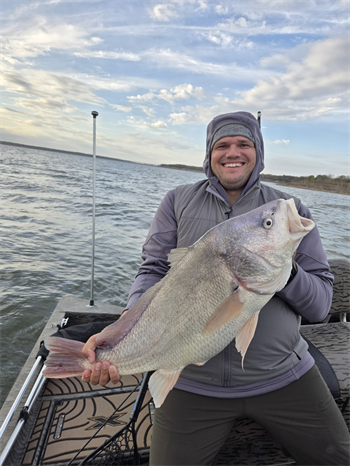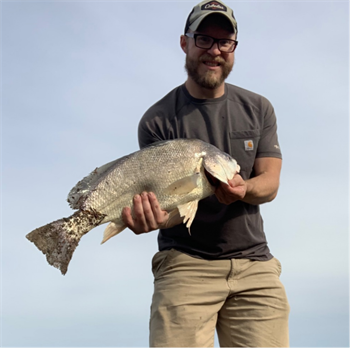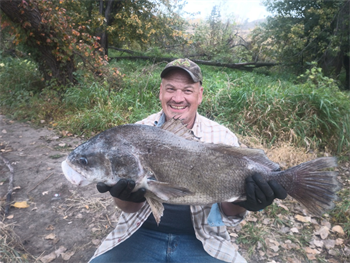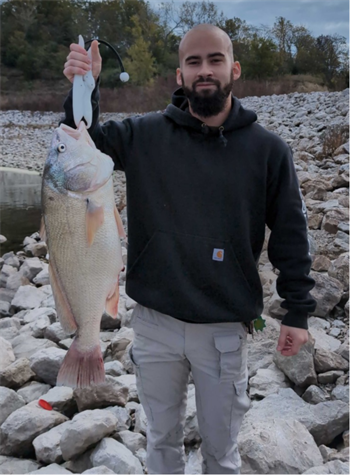Fish Iowa - Fish Species - Freshwater Drum
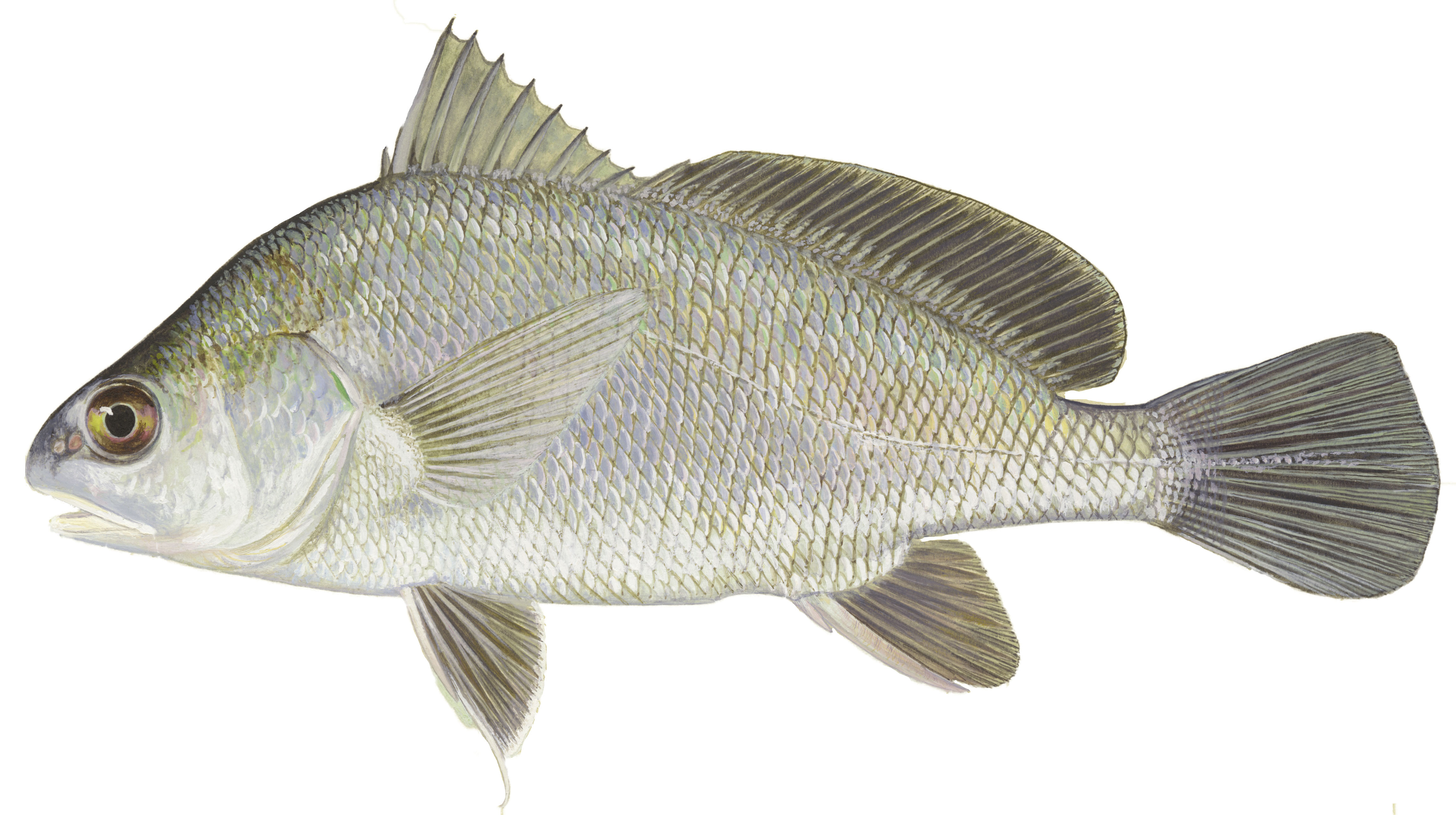
Characteristics
A deep-bodied, silvery fish whose head and body slope steeply up from the snout to the dorsal fin, resulting in a hump-backed look. It has a long dorsal fin that is divided into two lobes. The first has 8 to 9 spines, and the second has a single spine with 24 to 32 soft rays. The anal fin has 2 spines with the second spine larger than the first. The pelvic fin has one spine with 5 rays. Ctenoid scales cover the body and upper head. The lateral line is complete and extends through the caudal fin. The back is gray, with silvery sides and white belly and lower region of the head. Adults commonly weigh up to 5-pounds.
Foods
Drum spend most of their time on or near the bottom feeding mainly on fish, crayfish, and immature insects. Moving slowly along the bottom, it moves small rocks and other bottom materials with its snout, catching displaced aquatic life.
Expert Tip
Drum are bottom feeders that can be caught easily from the bank on nightcrawlers.
Details
The Freshwater Drum is usually found in shallow or muddy areas of large lakes, deep backwater pools of large rivers, and in reservoirs at depths of 30 feet or more. It avoids high gradient streams, waters with swift current and shallow, weedy areas, but can tolerate high turbidity.
The Freshwater Drum spawns in open waters. In the Mississippi River, drum spawn during May and June when the water temperatures are 66 to 72 degrees. Unique to the freshwater fish species in North America and characteristic of many saltwater fish, the eggs and larvae are buoyant and float on the water surface during development.
Growth studies in the Mississippi River report that Freshwater Drum average 5-inches long by the end of the first year of life and 8.0, 12.0, 13.5, 15.0, 17.0, 18.5, and 19.5-inches in succeeding years. Fast-growing drums in the Mississippi River reach 7 to 8 years of age, seldom more than 10 years, but there is a record of a 17 year old fish.
The drumming sound made when the fish is handled is produced by a special structure in the body cavity, which is connected with the swim bladder. Two elongated muscles move a tendon over the swim bladder and produce the sound. Only sexually mature males have this structure. Another unique feature of the drum is the large-sized otolith found in the sacculus. It has white, enameled surfaces and alternating light and dark bands that can be used to age the fish. Otoliths are often kept by fishermen for lucky pieces and sometimes made into jewelry.
Recent stream sampling information is available from Iowa DNR's biological monitoring and assessment program.
Sources:
Harlan, J.R., E.B. Speaker, and J. Mayhew. 1987. Iowa fish and fishing. Iowa Conservation Commission, Des Moines, Iowa. 323pp.
Loan-Wilsey, A. K., C. L. Pierce, K. L. Kane, P. D. Brown and R. L. McNeely. 2005. The Iowa Aquatic Gap Analysis Project Final Report. Iowa Cooperative Fish and Wildlife Research Unit, Iowa State University, Ames.
Illustration by Maynard Reece, from Iowa Fish and Fishing.
Distribution Map

Abundant in large rivers, such as the Missouri and Mississippi; found in larger inland rivers and streams. It is less common in the interior streams of northeast Iowa. It can be found in Iowa's larger impoundments, reservoirs and deep, natural lakes.
See our most recent distribution data for this species on the Iowa DNR's Bionet application.
State Record(s)
Master Angler Catches
Fish Surveys
Tip: Click Species Length by Site, then use the dropdown to filter by fish species of interest.Where this Fish Is Found
Atlantic Quarry Pond 1
Atlantic Quarry Pond 2
Atlantic Quarry Pond 4
Big Creek Lake
Big Lake (Lansing)
Big Pond
Big Sioux River
Big Timber Complex
Blue Heron Lake (Raccoon River Park)
Boyer River (Dunlap to Missouri River)
Burlington Street Dam
Bussey Lake
Cedar Lake
Cedar River (Cedar Rapids to Moscow)
Cedar River (La Porte City to Cedar Rapids)
Cedar River (Moscow to Columbus Junction)
Chariton River (below Rathbun Lake)
Coralville Reservoir
Des Moines River (Farmington to Keokuk)
Des Moines River (Ottumwa Dam to Farmington)
Des Moines River (Saylorville to Red Rock)
Des Moines River (Stratford to Saylorville Lake)
Des Moines Water Works Recharge Basins
DeSoto Bend at DeSoto National Wildlife Refuge
East Nishnabotna River
East Okoboji Lake
English River
Five in One Dam
Gateway Park North
Gimmel Lake
Grays Lake
Iowa River (Columbus Junction to Mississippi R)
Iowa River (Coralville Lake to River Junction)
Iowa River (Marshalltown to Coralville Lake)
Iowa River (River Junction to Columbus Junction)
Lake Macbride
Little Sioux River (Correctionville to Missouri R)
Little Sioux River (Linn Grove to Correctionville)
Little Sioux River (state line to Linn Grove)
Little Spirit Lake
Manhattan Robbins Lake Park
Maquoketa River (below Monticello)
Middle River
Missouri River (Council Bluffs to state line)
Missouri River (Little Sioux to Council Bluffs)
Missouri River (Sioux City to Little Sioux)
Mohawk Park Lake
New Albin Big Lake
North Raccoon River (Perry to Van Meter)
North River
North Twin Lake
Norwegian Lake
Pool 09, Mississippi River
Pool 11, Mississippi River
Pool 12, Mississippi River
Pool 13, Mississippi River
Pool 14, Mississippi River
Pool 15, Mississippi River
Pool 16, Mississippi River
Pool 17, Mississippi River
Pool 18, Mississippi River
Pool 19, Mississippi River
Prairie Park Fishery
RAPP Park Lakes
Red Rock Reservoir
Roberts Creek Lake
Sand Lake
Saylorville Reservoir
Skunk River (Coppock to Mississippi River)
Skunk River (Rose Hill to Coppock)
Spirit Lake
Tuttle Lake
Upper Iowa River (below Decorah)
Wapsipinicon River (Oxford Junct to Mississippi R)
West Nishnabotna River
West Okoboji Lake

